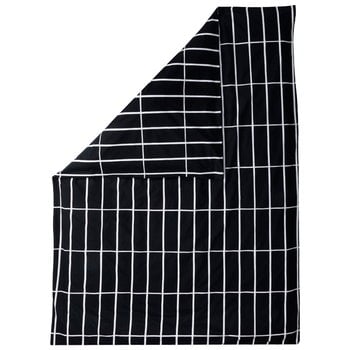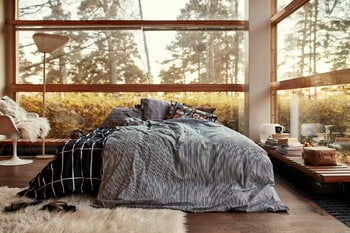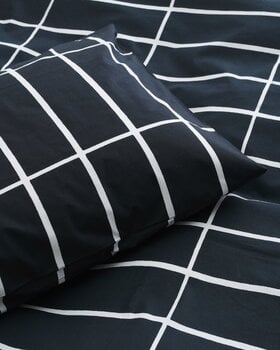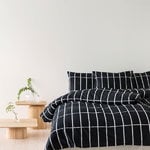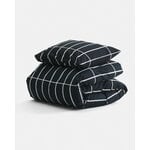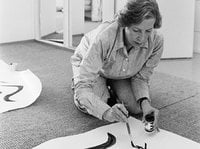Marimekko’s Tiiliskivi double duvet cover features a simple, black and white grid pattern designed by Armi Ratia in 1952. Timeless Tiiliskivi is perfect for minimalist interiors and creates an intriguing contrast with rich and colourful patterns. The black and white duvet cover is made of closely woven cotton percale, and it measures 240 cm x 220 cm.
Tiiliskivi double duvet cover, 240 x 220 cm
Marimekko
Description
Marimekko’s Tiiliskivi double duvet cover features a simple, black and white grid pattern designed by Armi Ratia in 1952. Timeless Tiiliskivi is perfect for minimalist interiors and creates an intriguing contrast with rich and colourful patterns. The black and white duvet cover is made of closely woven cotton percale, and it measures 240 cm x 220 cm.
Product details (5)
- Material
- 100% cotton (75% recycled, 25% organic cotton)
- Colour
- Black, white
- Length
- 220 cm
- Width
- 240 cm
- Care instructions
- Machine wash in 60 °C. Max. shrinkage 5%.
- Product ID
Designer
Armi Ratia (1912-1979) was a textile artist, the founder of Marimekko and one of the most famous Finnish entrepreneurs. She was the CEO of Marimekko until 1969 and again 1971 onwards. Ratia studied textile design in Helsinki and graduated in 1935. After graduating she founded her first enterprise, a weaving mill in Vyborg. In 1939 she had to leave the weaving mill as she moved to Helsinki together with her husband Viljo Ratia.
Marimekko's story can be said to have started when Armi Ratia joined Printex, a manufacturer of oilcloths and print fabric owned by Viljo Ratia. She began to acquire bold and colorful patterns for printing. Two years later Marimekko was born.
In the early days of Marimekko, Ratia sketched clothes and patterns on fabrics herself as well, but later on got more interested in marketing. She created the vision for Marimekko and found talented artists to implement it.
View all productsReviews (0)
Sustainability
The Product Sustainability Framework, our criteria of sustainable design, helps you find the most sustainable products in our selection. Read below which sustainability criteria this product has met.
Working conditions & labour 6/9
-
Equal opportunities for all employees
-
Commitment to UN Global Compact, fair compensation for all employees
-
Corporate responsibility requirements defined and communicated for suppliers
-
Systematic work for improved inclusion and well-being in the workplace
-
Transparent supply chain
-
Suppliers' compliance to a code of conduct ensured
-
Direct suppliers audited and certified
-
Compliance to the UN Guiding Principles on Business and Human Rights ensured in the supply chain
-
Support for community involvement in the supply chain
Eco-friendly production 6/9
-
Fair and resource-wise water-use in production
-
No incineration or landfilling of returned items
-
No use of endangered species as materials
-
No direct environmental emissions or waste (excl. GHGs) from production
-
The sustainability of direct suppliers' production is addressed and monitored
-
Material-efficient and ecological packaging
-
Production and material sourcing that respect biodiversity, animal rights, and natural ecosystems
-
Positive impact on nature’s well-being through operations that regenerate natural ecosystems
-
No potentially harmful chemicals used in own production
Climate impact 4/8
-
Company's direct greenhouse gas emissions identified and commitment to reduction
-
Product's carbon impact identified and commitment to reduction
-
Guidance on energy- and eco-efficient use of the product
-
Contribution to climate initiatives beyond the brand’s direct operations
-
Low-carbon or compensated transportation
-
Carbon footprint of the product calculated and goals set to reduce it
-
100 % renewable energy in own production and operations
-
Carbon neutral or carbon negative product
Sustainable materials 5/6
-
Sustainable and long-lasting material choices
-
No harmful or hazardous substances
-
Responsible raw material sourcing and production
-
Materials suited for circularity: monomaterials, recyclable finishings, renewable or recycled contents etc.
-
Ecological materials: natural, biodegradable, recyclable or recycled contents
-
Outstanding materials in terms of innovativeness, responsibility, sustainability and circularity: local production or sourcing, 100 % recycled content, C2C-certification etc.
Circular design 5/5
-
High aesthetic quality promoting long-term use of the product
-
Technically durable product design and material choices
-
Design for enduring life-long quality
-
Design and support for product maintenance, repair and upgradability
-
Innovative circular design solutions: circular service system, resale platform, remanufacturing, collection of used products, etc.
